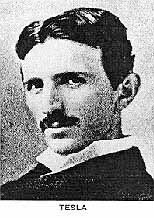Click HERE to go to home page -- (page 1)
Nikola Tesla--(Page 16)
A Short Chronology of the History of Electricity & Radio
Page 3.
1831 was a banner year for the world. Faraday had made his earthshaking discovery that electricity could be produced by magnetism. That same year James Clerk Maxwell was born.
Later in life Maxwell became a brilliant mathematician, eager to continue in Faraday's footsteps. His mathematical formulation of four equations serves as the foundation of the electromagnetic theory. He deduced that light was an electromagnetic wave, and that energy could be transmitted by electromagnetic waves at the speed of light.

Maxwell's discovery of the electromagnetic theory of light and the laws of electrodynamics are undoubtedly two of the most important events in the history of electrical science. They serve as the rock bed foundation for the world of communication we enjoy today. The "Maxwell" is the unit of magnetic flux.
________________________________________________________
In the late 1870's, the nature of electricity was still not well known. Maxwell's mathematical equations, electromagnetic theory of light, and laws of electrodynamics lacked hard experimental verification. Heinrich Hertz became a strong disciple of Maxwell's theories, and it was his work that proved Maxwell correct.

By 1888 Hertz had received world acclaim for his exhaustive experiments of electromagnetic wave phenomena concerning propagation, polarization, and reflection of waves. His discoveries opened the door to future work in the realm of radio. The "Hertz" is the unit for measurement of frequency.
________________________________________________________
The descriptions presented so far in this chronology of the greatest events in electrical history have been purposely brief in order to give the reader a general idea of what actually happened and who made it happen.
The time of the great pioneers was rapidly coming to a close. The period between 1888 to 1893 identifies two culminating events that mark the end of a long search: The search for understanding of our electromagnetic world. This knowledge would give us electrical power and radio communication.
Our last man to review stands on the threshold of a doorway that leads from pioneer to technologist, and he seems to be the one chosen to bridge the gap, for it becomes clear that his monumental discoveries were on both sides of that doorway.
We are talking, of course, about Nikola Tesla. Not only did Tesla finish the work started by Oersted and Faraday in the area of AC power, he also finished the work of Maxwell and Hertz in the area of high frequency phenomena--radio.

Tesla received US patents in 1888 for his rotating magnetic field principle, the product of which was his polyphase AC motor and generator, completing the last piece to the puzzle Oersted and Faraday had created. Tesla's system of AC power, used worldwide, remains virtually unchanged in principle today. His nature was such that he always paid tribute to those great men who came before him. He recognized their pioneering work as basic, making his discoveries possible.
After completing research in the low frequency field (60 Hertz AC), Tesla moved immediately into the field of high frequency research. In 1891 he solved the first puzzle in the art of radio by inventing what is now called a Tesla coil. It contains three ideas absolutely fundamental to all radios: (1). The idea of inductive coupling between the driving and working circuits; (2). the need for tuning both circuits so as to create an “oscillation transformer”; (3). the need for a capacitance loaded open secondary circuit. By 1893 he had devised his four-tuned circuit transmitter and receiver, and was first to publicly demonstrate the existence of wireless electromagnetic wave phenomena -- radio. The "Tesla" ("T") is the unit of magnetic flux density in the MKS system.
The End
John W. Wagner
3890 Tubbs Road
Ann Arbor, MI 48103 - 9437
USA
________________________________________________________
Click HERE to go back to Page 1.
Click HERE to go back one page.
Click HERE to send me a message.